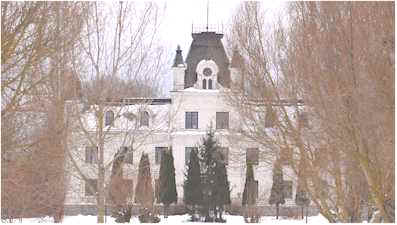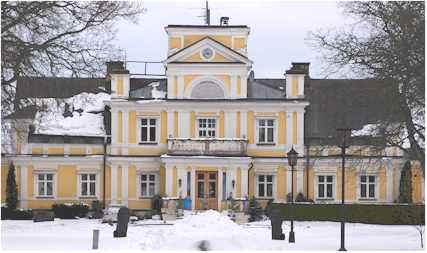 Sludge
Sludge 
on Swedish castles
 Sludge
Sludge 
[samma nivå]
[ underordnad sida ]
[ innehåll ]
Garbage backwaterIs Sweden with its Lake Hornborga nature preservation area becoming a garbage backwater? For two years the lake area has been exposed to sludge depositing, an activity sanctioned by environment prosecutors who have refused to take up charges against the sludge outrage. After having destroyed part of the park belonging to the medieval Axvalla Hus castle, the contractor has now by means of this grey gold been able to purchase another manor, St. Bjurum in the Västra Götaland region of Sweden. Immediately west of Lake Hornborga drained boglands lie open to the grey trade with our faeces and other discharges. Erik Soop, one of Gustavus Adolphus’ generals, is now turning in his stately sarcophagus in Skara Cathedral, when seeing his manor being degraded into a garbage station. This will finally complete the pollution of the banks and marshes on the west side of Lake Hornborga. The garbage supplier is the new estate owner of St. Bjurum, who is also responsible for delivering sludge to the other major farms on the west side of Lake Hornborga, famous for its cranes. This has not gone on without lively protests, but with the sanction of the authorities.
Map over Lake Hornborga and sludge deposits. Six times in the last two centuries the lake has been subjected to unfortunate and in some cases illegal lowering attempts. In more recent times the well-known and greatly praised lake has been given rehabilitation support half-heartedly but expensively. A sum of 250 million SEK has been mentioned. The value of these wetlands has increased strongly now that hundreds of thousands of tourists arrive to watch the cranes, making this area, somewhat surprisingly, one of Sweden’s most visited tourist spots. Investments in the cranes and their habitat indicate that these dancing birds on Lake Hornborga are hatching golden eggs. Furthermore, the crane has been allotted to Sweden by the European Commission as its national dancing ikon. It is true that the Province of Västergötland needs boosting economically, now that traditional farming can no longer undergo further structuring, due to the lack of a worthy agricultural policy. With the help of new economies, involving grey gold and black cows contractors try to make farmland, bought at reduced prices, pay dividend. For a number of years now a profitable deposition of digested sludge has been going on west of Lake Hornborga. The tactics are that the sludge carriers suddenly just arrive and throw off their sewage on distant bog fields. This happens without giving access to any reasonable control following what little a toothless Environment Act can offer. The fertilization is not governed by the annual needs of the plants, but every dumped load will provide the need for 70 years to come. This affects all the big estates on the west side, whose owners made the illegal encroachments on the lake in the 19th and 20th centuries. Consequently, the present owner carries on the tradition of large-scale destruction of the lake as in the past. The municipalities of West Sweden hand over their digested sludge for big sums of money to insensitive recipients without bothering to find out where it will be deposited. Thus sludge has, for example, been dumped near the canals draining the fields around the lake. Remarkably enough, they include the cranes’ resting-places and bird sanctuary close to the popular Crane Dance.
This deposits in protected area were turned down by the procecutor. Turned down by the environment prosecutor. The threat against Bjurum, home of the beaver, is becoming real, since the new owner intends to give notice to leave to the farmer who has for two generations successfully farmed the big estate. At present a prosperous milk production with 200 milk cows and a frequently visited farm butchery are run on the estate grounds. To pay the purchasing price of 15 million SEK only, there is now room for depositing enough sludge to make the owner free from debts within short. The turnover of depositions at the neighbouring estate of Dagsnäs was ca three to four million SEK. Besides, the planning is already going ahead for utilising areas hard of access to the public – on preservation areas, naturally. The past has shown that there is no danger from the penalty perspective.
Will this be the future wiev of St. Bjurum west of Lake Hornborga ? Replacing food production with digested and undigested sludge from municipalities in the West of Sweden and maybe from other corners of Europe as well will not be acceptable to public opinion facing a general election in the autumn. Planning for new golf courses on game reserves within protected areas are nothing but excuses for depositing enormous masses of sludge on future greens. The loose moss soil, drained by hand in the 19th century, will sooner or later seep fertilisation into the already over-fertilised lake. The silent people also include nature preservation and ornithological societies, which only turn their back and frantically count the number of birds without noticing the ecological and economic misuse that takes place behind their backs. The County Administration Environmental Section makes light of what happens in their areas of responsibility and put obstacles in the way of public debates on this issue, with the support of the tourist industry, which does not want a negative debate on the lake and its lucrative cranes. The fact that the County Administration has even tried to make the police withdraw a permit for a justified protest at the Hornborgasjön Crane Dance does not make the issue any less remarkable. The whole of the western bank of the lake is exposed. Worst affected of all is the St. Bjurum estate, which will be a garbage pile and final deposition of city backyards. Even at the medieval ruins of Gudhem nunnery sludge has been deposited for years without the exclamations of the neighbours having succeeded the least in getting the authorities to protect this cultural heritage. The deliverer is the owner of Bjurum! No authority wants to take responsibility for the situation, there is much money hidden in this enterprise, the municipalities want to get rid of their sludge and the turnover is great. When will the environmentalists wake up? And where does the sludge end up? A seminar
The walls of the Zettervall manor have started to crack and plaster is falling off this more than 100-year-old building. But the whole of St. Bjurum has already begun to fall apart, since the leasing committee wants to put a stop to its functioning profit-making food-producing farming by handling garbage in a way that in the long run will lay Lake Hornborga waste. Old drained moss fields are renamed game fields or salix fields. Excavators are already preparing for the transportation of excrements to nature preservation areas on the estate. Black cows and grey gold is supposed to replace today’s functioning use of the soil. The old saying on the gates of the manor: “Where the law ends, honour begins” no longer applies. But Lake Hornborga is not just a future sludge lake but also a world heritage! Mailing list: As a public document to: For information to:
Lokal authorities in Norway, Denmark and Finland. An English version to
Cranes and sludge at Lake Hornborga.Resting cranes may spread bird flue from the island of Rügen are forced to stop at the dung fields of Dagsnäs and Stora Bjurum. For 100 years Lake Hornborgasjön may have served as a resting-place for cranes. This development was stimulated by the potato fields for the production of aqua vitae at the estates of Stora Bjurum and Dagsnäs and the sewage it generated. Ever since this production ceased attempts have been made to get the birds to stop on Lake Hornborgasjön. To support this the cultivation of potatoes has continued and, more recently, feeding the birds with grain has attracted hundreds of thousands of tourists. This has turned the crane into the international nature symbol of the Province of Västergötland and of Sweden. Visits have increased over the years, with peak figures frequently amounting to 12,000 dancing birds per year. Their nearest point of departure is Spain with a regular stop-over on Rügen. The feeding on Lake Hornborgasjön tends to prolong their stay until they are driven by their hormones to mate and nest in some silent northern marshland. Recent environmental impact may, however, retard this development. The large estates of Dagsnäs och Stora Bjurum, which in the last two centuries were responsible for the unprofitable and illegal lowering of the surface of the lake, have invented new ways of turning the soil into profit. Now that potatoes no longer produce aqua vitae and money, the drained wetlands are now called game habitats. This new name has succeeded in confusing the authorities responsible for the environment as well as the public prosecutors. The estates make great profits from receiving thousands of tons of sludge from the Västergötland municipalities. The contractor who has profited greatly from trading with municipality faeces has purchased one of the estates, which will now be affected by sludge depositing. Several properties in the Hornborgasjön area are in danger of being purchased and used to extract sewage sludge, which interferes with the resting of the cranes. The bird-protected area prevents the public from gaining insight into this process, which literally takes place behind the backs of the hundreds of thousands of visiting crane watchers. Since there is no longer any political interest in nature conservation, the environmental prosecutor can disregard any petition, however justified, without the risk of being criticized.
But there is more at stake for the cranes than stalking about in excrement during their stopover on Lake Hornborgasjön. They are also exposed to a new threat in the form of H5N1, the Avian Influenza, which they pick up on the island of Rügen. There are great possibilities for them to spread this disease among related species like swans, geese and crow birds happily helping themselves to the rye that is being served. Everyone knows about the toothlessness of the Environment Act, but the Infectious Disease Control Act, with its roots in the miserable sewage handling in 18th century cities, can possibly influence the debate about the handling of sewage on the lake. The interesting point is that this act, which came into being before anybody even knew about bacteria and viruses, has today become our most mandatory legislation. Will this act be able to save our badly treated but highly celebrated Lake Hornborgasjön from the biggest threat of the century? Will Infectious Disease Control open our eyes to what is going on in the major tourist area of Västergötland?
|
[samma nivå]
[ underordnad sida ]
[ innehåll ]
![]()